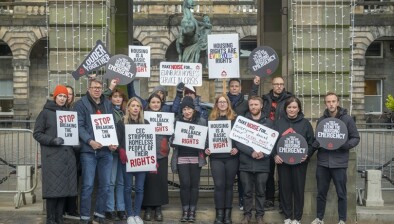Marginal decrease in households in temporary accommodation as arrears remain steady, Regulator finds

The number of households currently living in temporary accommodation in Scotland has marginally decreased since March 2021 while social landlord levels have remained stable, according to figures from the Scottish Housing Regulator.
The first quarterly dashboard report covering the period 1 April 2021 to 30 June 2021, published by the Regulator yesterday, revealed that the total number of households in temporary accommodation on the last day of the quarter stood at 13,152, which was 179 fewer than the previous quarter.
There was also an increase in the number of households not offered temporary accommodation when needed during the quarter, up 52 households to reach 85.
“We are currently engaging with all of Scotland’s local authorities to monitor and assess their approach to performing their statutory duty to provide settled accommodation to all those assessed as being unintentionally homeless,” the Regulator stated.
The dashboard report is designed to help the Scottish Government and social landlords to understand the continuing impact of the coronavirus pandemic and to support the work of the Social Housing Resilience Group.
Since April 2020, all social landlords have been providing the Regulator with a monthly return on a small set of key measures that focus on the main areas of impact on landlords’ operations. From April 2021, the frequency of the returns changed from monthly to quarterly. The first quarterly returns were due from landlords on 20 July 2021.
The March dashboard showed that rent arrears had fallen to their lowest level since the Regulator started collecting monthly returns from social landlords in April 2020. The first quarterly return confirms that arrears levels have remained stable since March 2021.
The quarterly returns also include some additional indicators including information on re-let times and rent lost from properties being empty.
Commenting on the figures, Alison Watson, director of Shelter Scotland, said: “Shelter Scotland welcomes the small drop in the number of people currently living in temporary accommodation waiting for a safe, permanent home.
“We recognise the work of frontline council staff who are providing lifeline services to people who would otherwise have nowhere to go.
“It is concerning to see an increase in the number of times councils have failed to offer accommodation to people when they needed it and when there is a legal obligation to do so.
“Scotland had a housing emergency before the pandemic. We used to have hundreds of people sleeping rough on our streets every night. We don’t want to go back there. That’s why we want to see the Scottish Government working urgently to help councils secure the accommodation and other resources they need to ensure we come out of this health crisis having transformed the way we tackle homelessness. Right now, everything possible should be done to prevent more people becoming homeless and we want to see the temporary ban on evictions reinstated to keep people in their homes.”








